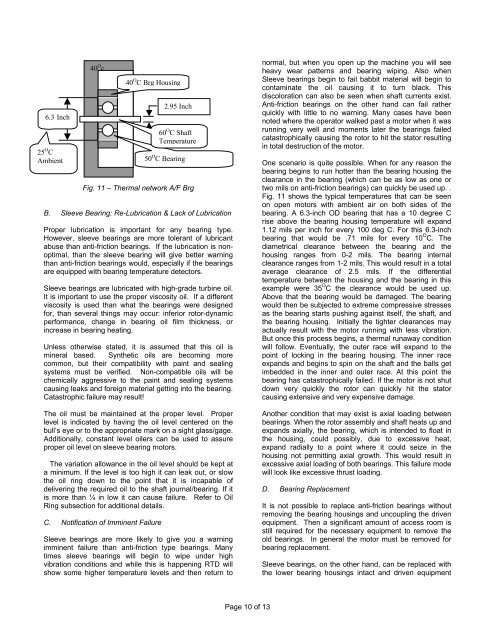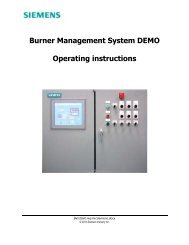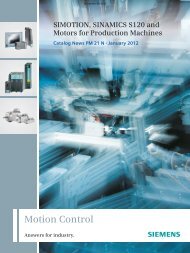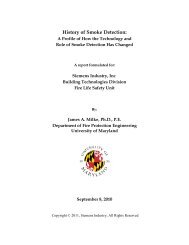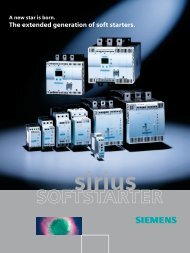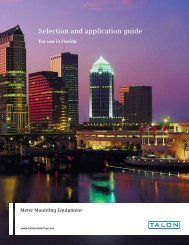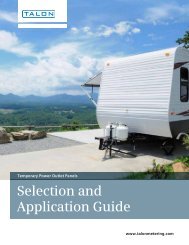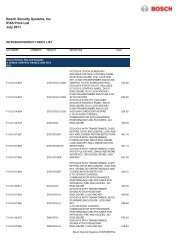Sleeve vs Antifriction Bearings - Siemens Industry, Inc.
Sleeve vs Antifriction Bearings - Siemens Industry, Inc.
Sleeve vs Antifriction Bearings - Siemens Industry, Inc.
You also want an ePaper? Increase the reach of your titles
YUMPU automatically turns print PDFs into web optimized ePapers that Google loves.
6.3 <strong>Inc</strong>h25 O CAmbient40 O c40 O C Brg HousingFig. 11 – Thermal network A/F BrgB. <strong>Sleeve</strong> Bearing: Re-Lubrication & Lack of LubricationProper lubrication is important for any bearing type.However, sleeve bearings are more tolerant of lubricantabuse than anti-friction bearings. If the lubrication is nonoptimal,than the sleeve bearing will give better warningthan anti-friction bearings would, especially if the bearingsare equipped with bearing temperature detectors.<strong>Sleeve</strong> bearings are lubricated with high-grade turbine oil.It is important to use the proper viscosity oil. If a differentviscosity is used than what the bearings were designedfor, than several things may occur: inferior rotor-dynamicperformance, change in bearing oil film thickness, orincrease in bearing heating.Unless otherwise stated, it is assumed that this oil ismineral based. Synthetic oils are becoming morecommon, but their compatibility with paint and sealingsystems must be verified. Non-compatible oils will bechemically aggressive to the paint and sealing systemscausing leaks and foreign material getting into the bearing.Catastrophic failure may result!The oil must be maintained at the proper level. Properlevel is indicated by having the oil level centered on thebull’s eye or to the appropriate mark on a sight glass/gage.Additionally, constant level oilers can be used to assureproper oil level on sleeve bearing motors.The variation allowance in the oil level should be kept ata minimum. If the level is too high it can leak out, or slowthe oil ring down to the point that it is incapable ofdelivering the required oil to the shaft journal/bearing. If itis more than ¼ in low it can cause failure. Refer to OilRing subsection for additional details.C. Notification of Imminent Failure2.95 <strong>Inc</strong>h60 O C ShaftTemperature50 O C Bearing<strong>Sleeve</strong> bearings are more likely to give you a warningimminent failure than anti-friction type bearings. Manytimes sleeve bearings will begin to wipe under highvibration conditions and while this is happening RTD willshow some higher temperature levels and then return tonormal, but when you open up the machine you will seeheavy wear patterns and bearing wiping. Also when<strong>Sleeve</strong> bearings begin to fail babbit material will begin tocontaminate the oil causing it to turn black. Thisdiscoloration can also be seen when shaft currents exist.Anti-friction bearings on the other hand can fail ratherquickly with little to no warning. Many cases have beennoted where the operator walked past a motor when it wasrunning very well and moments later the bearings failedcatastrophically causing the rotor to hit the stator resultingin total destruction of the motor.One scenario is quite possible. When for any reason thebearing begins to run hotter than the bearing housing theclearance in the bearing (which can be as low as one ortwo mils on anti-friction bearings) can quickly be used up. .Fig. 11 shows the typical temperatures that can be seenon open motors with ambient air on both sides of thebearing. A 6.3-inch OD bearing that has a 10 degree Crise above the bearing housing temperature will expand1.12 mils per inch for every 100 deg C. For this 6.3-inchbearing that would be .71 mils for every 10 O C. Thediametrical clearance between the bearing and thehousing ranges from 0-2 mils. The bearing internalclearance ranges from 1-2 mils. This would result in a totalaverage clearance of 2.5 mils. If the differentialtemperature between the housing and the bearing in thisexample were 35 O C the clearance would be used up.Above that the bearing would be damaged. The bearingwould then be subjected to extreme compressive stressesas the bearing starts pushing against itself, the shaft, andthe bearing housing. Initially the tighter clearances mayactually result with the motor running with less vibration.But once this process begins, a thermal runaway conditionwill follow. Eventually, the outer race will expand to thepoint of locking in the bearing housing. The inner raceexpands and begins to spin on the shaft and the balls getimbedded in the inner and outer race. At this point thebearing has catastrophically failed. If the motor is not shutdown very quickly the rotor can quickly hit the statorcausing extensive and very expensive damage.Another condition that may exist is axial loading betweenbearings. When the rotor assembly and shaft heats up andexpands axially, the bearing, which is intended to float inthe housing, could possibly, due to excessive heat,expand radially to a point where it could seize in thehousing not permitting axial growth. This would result inexcessive axial loading of both bearings. This failure modewill look like excessive thrust loading.D. Bearing ReplacementIt is not possible to replace anti-friction bearings withoutremoving the bearing housings and uncoupling the drivenequipment. Then a significant amount of access room isstill required for the necessary equipment to remove theold bearings. In general the motor must be removed forbearing replacement.<strong>Sleeve</strong> bearings, on the other hand, can be replaced withthe lower bearing housings intact and driven equipmentPage 10 of 13


